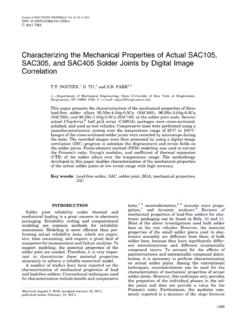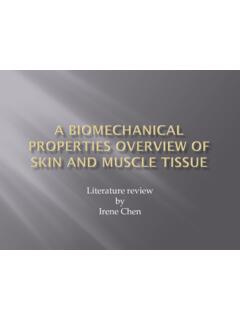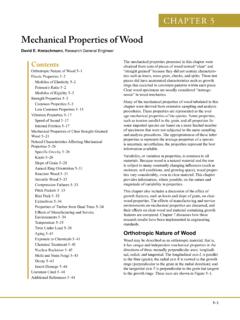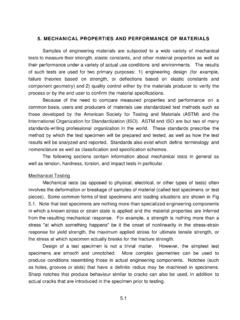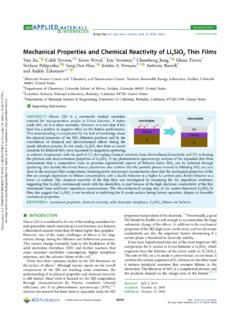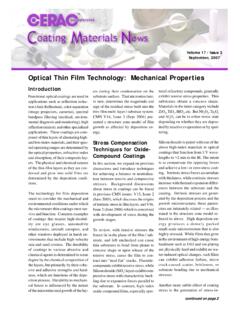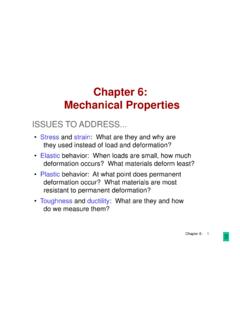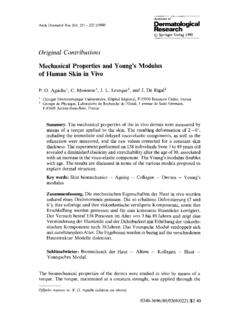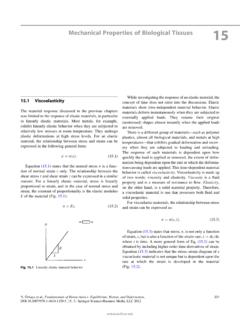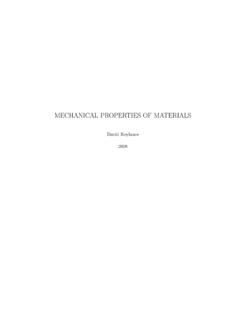Transcription of Chapter 6: Mechanical Properties - Armstrong
1 Chapter 6 -1 ISSUES TO Stressand strain: What are they and why arethey used instead of load and deformation? Elasticbehavior: When loads are small, how much deformation occurs? What materials deform least? Plasticbehavior: At what point does permanent deformation occur? What materials are most resistant to permanent deformation? Toughnessand ductility: What are they and howdo we measure them? Chapter 6: Mechanical Properties Chapter 6 -2 Elastic means reversible!Elastic Deformation2. Small loadFdbonds stretch1. Initial3. Unloadreturn to initialFdLinear-elasticNon-Linear-elasti cChapter 6 -3 Plastic means permanent!
2 Plastic Deformation (Metals)Fdlinear elasticlinear elasticdplastic1. Initial2. Small load3. Unloadplanesstill shearedFdelastic + plasticbonds stretch & planes sheardplasticChapter 6 -4 Stress has units:N/m2or lbf/in2 Engineering Stress Shearstress, t:Area, AoFtFtFsFFFst=FsAo Tensilestress, s:original area before loadings=FtAo2f2mNorinlb=Area, AoFtFtChapter 6 -5 Simpletension: cableNote: t= States of Stressos=FAot=FsAssMMAo2 RFsAc Torsion(a form of shear): drive shaftSki lift(photo courtesy Anderson)Ao= cross sectional area (when unloaded)FFChapter 6 -6 TensileCompressiveShearTorsionChapter 6 -7(photo courtesy Anderson)Canyon Bridge, Los Alamos, NMos=FA Simplecompression:Note: compressivestructure member(s< 0 here).
3 (photo courtesy Anderson)OTHER COMMON STRESS STATES (i)AoBalanced Rock, Arches National ParkChapter 6 -8 Bi-axialtension: Hydrostaticcompression:Pressurized tanks< 0h(photo Anderson)(photo Anderson)OTHER COMMON STRESS STATES (ii)Fish under watersz> 0sq> 0 Chapter 6 -9 Tensilestrain: Lateralstrain:Strain is Strain Shearstrain:q90 90 -qy xqg= x/y= tan e=dLoAdapted from Fig. (a) and (c), Callister & Rethwisch 6 -Poisson s Ratio10 Chapter 6 -11 Stress-Strain Testing Typical tensile test machineAdapted from Fig. , Callister & Rethwisch 8e.
4 (Fig. is taken from Hayden, Moffatt, and J. Wulff, The Structure and Properties of Materials, Vol. III, Mechanical Behavior, p. 2, John Wiley and Sons, New York, 1965.)specimenextensometer Typical tensile specimenAdapted from Fig. ,Callister & Rethwisch lengthChapter 6 -12 MetalsAlloysGraphiteCeramicsSemicondPoly mersComposites/fibersE(GPa)Based on data in Table ,Callister & Rethwisch data based onreinforced epoxy with 60 vol%of alignedcarbon (CFRE),aramid (AFRE), orglass (GFRE) s Moduli: ,AluminumPlatinumSilver, GoldTantalumZinc, TiSteel, NiMolybdenumGraphiteSi crystalGlass-sodaConcreteSi nitrideAl oxidePCWood( grain)AFRE( fibers)*CFRE*GFRE*Glass fibers onlyCarbon fibers onlyAramid fibers onlyEpoxy alloysTungsten<100> <111>Si carbideDiamondPTFEHDPELDPEPPP olyesterPSPETCFRE( fibers)*GFRE( fibers)*GFRE(|| fibers)*AFRE(|| fibers)*CFRE(|| fibers)* Chapter 6 -13(at lower temperatures, T< Tmelt/3)Plastic (Permanent) Deformation Simple tension test.
5 Engineering stress, sengineering strain, eElastic+Plastic at larger stressepplastic strainElastic initiallyAdapted from Fig. (a),Callister & Rethwisch (plastic) after load is removedChapter 6 -14 Stress at which noticeableplastic deformation ep= Yield Strength, sysy= yield strengthNote: for 2 inch samplee= = z/z z= inAdapted from Fig. (a),Callister & Rethwisch stress, sengineering strain, esyep= 6 -15 Room temperaturevaluesBased on data in Table ,Callister & Rethwisch = annealedhr = hot rolledag = agedcd = cold drawncw = cold workedqt = quenched & temperedYield Strength.
6 ComparisonGraphite/ Ceramics/ SemicondMetals/ AlloysComposites/ fibersPolymersYield strength,sy(MPa)PVCHard to measure, since in tension, fracture usually occurs before 6,6 LDPE702040605010010302003004005006007001 0002000 Tin (pure)Al(6061)aAl(6061)agCu(71500)hrTa(p ure)Ti (pure)aSteel(1020)hrSteel(1020)cdSteel(4 140)aSteel(4140)qtTi ( )aW(pure)Mo (pure)Cu(71500)cwHard to measure, in ceramic matrix and epoxy matrix composites, sincein tension, fracture usually occurs before Chapter 6 -16 Tensile Strength, TS Metals:occurs when noticeable neckingstarts.
7 Polymers:occurs when polymer backbonechainsarealigned and about to from Fig. , Callister & Rethwisch response of a metalF= fracture or ultimate strengthNeck acts as stress concentratorengineering TSstressengineering strain Maximum stress on engineering stress-strain 6 -17 Tensile Strength: ComparisonSi crystal<100>Graphite/ Ceramics/ SemicondMetals/ AlloysComposites/ fibersPolymersTensilestrength, TS(MPa)PVCN ylon 6,6101002003001000Al(6061)aAl(6061)agCu( 71500)hrTa(pure)Ti (pure)aSteel(1020)Steel(4140)aSteel(4140 )qtTi ( )aW(pure)Cu(71500)cwLDPEPPPCPET203040200 030005000 GraphiteAl oxideConcreteDiamondGlass-sodaSi nitrideHDPE wood( fiber)wood(|| fiber)1 GFRE(|| fiber)GFRE( fiber)CFRE(|| fiber)CFRE( fiber)AFRE(|| fiber)AFRE( fiber)
8 E-glass fibCfibersAramidfibBased on data in Table ,Callister & Rethwisch = annealedhr = hot rolledag = agedcd = cold drawncw = cold workedqt = quenched & temperedAFRE, GFRE, & CFRE =aramid, glass, & carbonfiber-reinforced epoxycomposites, with 60 vol% temperaturevaluesChapter 6 -18 Plastic tensile strain at failure:Ductility Another ductility measure:100xAAARA%ofo-=x 100 LLLEL%oof-=LfAoAfLoAdapted from Fig. , Callister & Rethwisch tensile strain, eEngineering tensile stress, ssmaller %ELlarger %ELChapter 6 -19 Energy to break a unit volume of material Approximate by the area under the stress-strain fracture:elastic energyDuctile fracture:elastic + plastic energyAdapted from Fig.
9 , Callister & Rethwisch small toughness (unreinforced polymers) Engineering tensile strain, eEngineering tensile stress, ssmall toughness (ceramics)large toughness (metals) Chapter 6 -20 Resilience, Ur Ability of a material to store energy Energy stored best in elastic regionIf we assume a linear stress-strain curve this simplifies toAdapted from Fig. , Callister & Rethwisch @ ees=ydUr0 Chapter 6 -21 Elastic Strain RecoveryAdapted from Fig. , Callister & Rethwisch Reapplyload2. UnloadDElastic strainrecovery1. LoadsyosyiChapter 6 -22 Hardness Resistance to permanently indenting the surface.
10 Large hardness means:--resistance to plastic deformation or cracking wear , 10 mm sphereapply known force measure size of indent after removing loaddDSmaller indents mean larger hardnessmost plasticsbrasses Al alloyseasy to machine steelsfile hardcutting toolsnitrided steelsdiamondChapter 6 -23 Hardness: Measurement Rockwell No major sample damage Each scale runs to 130 but only useful in range 20-100. Minor load 10 kg Major load 60 (A), 100 (B) & 150 (C) kg A = diamond, B = 1/16 in. ball, C = diamond HB = Brinell Hardness TS(psia) = 500 x HB TS (MPa) = x HBChapter 6 -24 Hardness: MeasurementTable 6 -25 True Stress & StrainNote: changes when sample stretched True stress True strainiTAF=s oiT ln=e e =ee s=s1ln1 TTAdapted from Fig.
